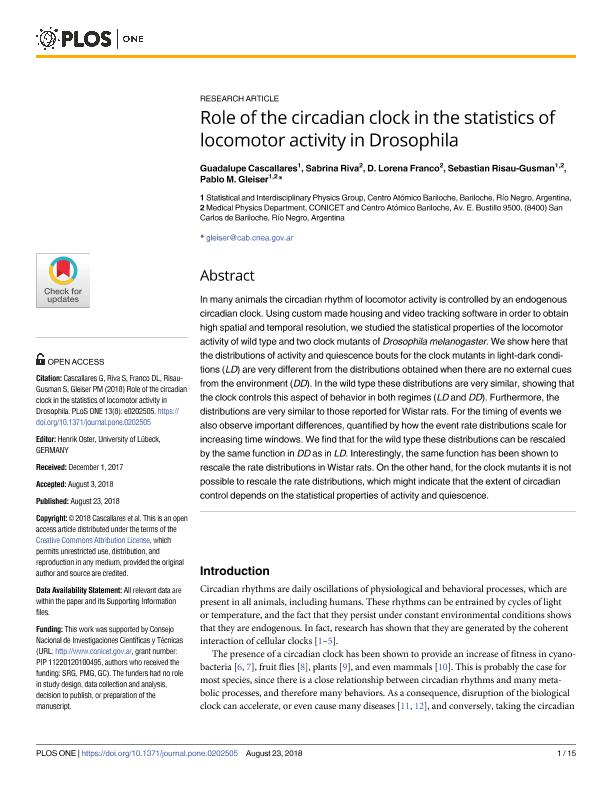Mostrar el registro sencillo del ítem
dc.contributor.author
Cascallares, Maria Guadalupe

dc.contributor.author
Riva, Sabrina Carla

dc.contributor.author
Franco, Diana Lorena

dc.contributor.author
Risau Gusman, Sebastian Luis

dc.contributor.author
Gleiser, Pablo Martin

dc.date.available
2021-02-18T15:33:00Z
dc.date.issued
2018-08
dc.identifier.citation
Cascallares, Maria Guadalupe; Riva, Sabrina Carla; Franco, Diana Lorena; Risau Gusman, Sebastian Luis; Gleiser, Pablo Martin; Role of the circadian clock in the statistics of locomotor activity in Drosophila; Public Library of Science; Plos One; 13; 8; 8-2018; 1-15
dc.identifier.issn
1932-6203
dc.identifier.uri
http://hdl.handle.net/11336/125961
dc.description.abstract
In many animals the circadian rhythm of locomotor activity is controlled by an endogenous circadian clock. Using custom made housing and video tracking software in order to obtain high spatial and temporal resolution, we studied the statistical properties of the locomotor activity of wild type and two clock mutants of Drosophila melanogaster. We show here that the distributions of activity and quiescence bouts for the clock mutants in light-dark conditions (LD) are very different from the distributions obtained when there are no external cues from the environment (DD). In the wild type these distributions are very similar, showing that the clock controls this aspect of behavior in both regimes (LD and DD). Furthermore, the distributions are very similar to those reported for Wistar rats. For the timing of events we also observe important differences, quantified by how the event rate distributions scale for increasing time windows. We find that for the wild type these distributions can be rescaled by the same function in DD as in LD. Interestingly, the same function has been shown to rescale the rate distributions in Wistar rats. On the other hand, for the clock mutants it is not possible to rescale the rate distributions, which might indicate that the extent of circadian control depends on the statistical properties of activity and quiescence.
dc.format
application/pdf
dc.language.iso
eng
dc.publisher
Public Library of Science

dc.rights
info:eu-repo/semantics/openAccess
dc.rights.uri
https://creativecommons.org/licenses/by/2.5/ar/
dc.subject
Drosophila melanogaster
dc.subject
Chronobiology
dc.subject
Circadian Rhythms
dc.subject
Locomotor activity
dc.subject.classification
Otras Ciencias Biológicas

dc.subject.classification
Ciencias Biológicas

dc.subject.classification
CIENCIAS NATURALES Y EXACTAS

dc.title
Role of the circadian clock in the statistics of locomotor activity in Drosophila
dc.type
info:eu-repo/semantics/article
dc.type
info:ar-repo/semantics/artículo
dc.type
info:eu-repo/semantics/publishedVersion
dc.date.updated
2021-02-09T18:46:33Z
dc.journal.volume
13
dc.journal.number
8
dc.journal.pagination
1-15
dc.journal.pais
Estados Unidos

dc.journal.ciudad
San Francisco
dc.description.fil
Fil: Cascallares, Maria Guadalupe. Comisión Nacional de Energía Atómica. Centro Atómico Bariloche; Argentina. Consejo Nacional de Investigaciones Científicas y Técnicas. Centro Científico Tecnológico Conicet - Patagonia Norte; Argentina
dc.description.fil
Fil: Riva, Sabrina Carla. Comisión Nacional de Energía Atómica. Centro Atómico Bariloche; Argentina
dc.description.fil
Fil: Franco, Diana Lorena. Comisión Nacional de Energía Atómica. Centro Atómico Bariloche; Argentina. Consejo Nacional de Investigaciones Científicas y Técnicas. Centro Científico Tecnológico Conicet - Patagonia Norte; Argentina
dc.description.fil
Fil: Risau Gusman, Sebastian Luis. Comisión Nacional de Energía Atómica. Centro Atómico Bariloche; Argentina. Consejo Nacional de Investigaciones Científicas y Técnicas. Centro Científico Tecnológico Conicet - Patagonia Norte; Argentina
dc.description.fil
Fil: Gleiser, Pablo Martin. Comisión Nacional de Energía Atómica. Centro Atómico Bariloche; Argentina. Consejo Nacional de Investigaciones Científicas y Técnicas. Centro Científico Tecnológico Conicet - Patagonia Norte; Argentina
dc.journal.title
Plos One

dc.relation.alternativeid
info:eu-repo/semantics/altIdentifier/doi/https://doi.org/10.1371/journal.pone.0202505
dc.relation.alternativeid
info:eu-repo/semantics/altIdentifier/url/https://journals.plos.org/plosone/article?id=10.1371/journal.pone.0202505
Archivos asociados
